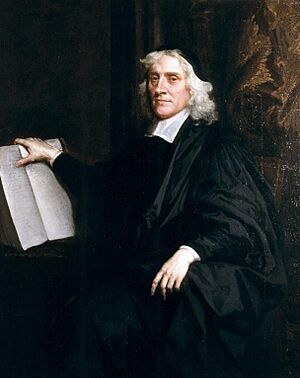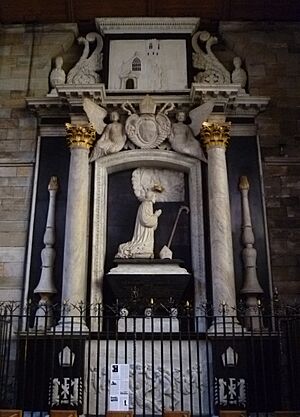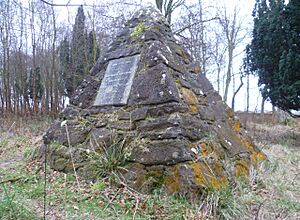James Sharp (bishop) facts for kids
Quick facts for kids Most Reverend James Sharp |
|
|---|---|

Archbishop James Sharp by Peter Lely
|
|
| Church | Church of Scotland |
| Archdiocese | Archbishop of St Andrews |
| In Office | 1661 to 1679 |
| Predecessor | John Spottiswoode |
| Successor | Alexander Burnet |
| Orders | |
| Consecration | 15 December 1661 by Gilbert Sheldon George Morley |
| Personal details | |
| Birth name | James Sharp |
| Born | 4 May 1618 Banff Castle |
| Died | 2 May 1679 (aged 60) Magus Muir, Fife |
| Spouse | Helen Moncrieff (1622–1679) |
| Children | 7 |
| Alma mater | University of Aberdeen |
James Sharp (born May 4, 1618 – died May 3, 1679) was an important leader in the Church of Scotland. He served as the Archbishop of St Andrews from 1661 until his death in 1679. His strong support for a church system led by bishops, called Episcopalianism, caused big disagreements. This put him in conflict with other church members who preferred a system led by elders, known as Presbyterianism. James Sharp faced two attempts on his life, and the second one was sadly successful.
Contents
Who Was James Sharp?
Early Life and Family Background
James Sharp was born on May 4, 1618, at Banff Castle in Scotland. He was the oldest son of William Sharp and Isabel Leslie. His father managed properties for a wealthy family, the Earl of Findlater. His mother was the daughter of the Laird of Kininvie.
James had a younger brother, Sir William Sharp of Stonihill. William became an important political helper for the Duke of Lauderdale. The Duke was Scotland's Secretary of State from 1661 to 1680.
In April 1653, James Sharp married Helen Moncrieff. She was the daughter of the laird of Randerston. Together, they had seven children.
Understanding Church Differences
Episcopalian vs. Presbyterian Church Systems
In the 17th century, the terms Presbyterian and Episcopalian mainly described how a church was run. They didn't mean big differences in beliefs. Episcopalian meant the church was governed by bishops. These bishops were usually chosen by the king or queen.
Presbyterian meant the church was led by Elders. These elders were chosen by the church members themselves. After the Protestant Reformation, the Church of Scotland (often called the 'kirk') became Presbyterian in its structure. Its beliefs were based on Calvinism.
When bishops were brought into the Scottish church in 1584, they still held Calvinist beliefs. They disagreed with many practices of the Church of England. These differences made it hard to unite the two churches.
The Covenanters and Political Changes
In 1638, a group called the Covenanters signed the National Covenant. This agreement removed bishops from the kirk and led to a Covenanter government in Scotland. This government ruled during the Wars of the Three Kingdoms (1638-1651).
After a royalist defeat in 1647, the Covenanters split into two groups. One group was more moderate, called the Engagers. The other was stricter, known as the Kirk Party. Both groups believed that kings were chosen by God. However, they disagreed on who should have the final say in church matters.
Scotland tried to bring back King Charles I, and then his son King Charles II, to the English throne. These efforts failed. In 1652, Scotland became part of the Commonwealth of England, Scotland and Ireland. The kirk split again. A moderate group called the Resolutioners formed. Another group, the 'Protestors', blamed their defeats on compromises. These groups had religious and political differences. They disagreed on church leadership, religious freedom, and the role of law in a religious society.
These splits often led to the winning side removing the losing side from their church positions. This caused a lot of anger.
James Sharp's Career Journey
Education and Early Ministry
James Sharp went to a local grammar school. In 1637, he graduated from King's College, Aberdeen. The university and the Banff area generally supported Episcopalianism. It was one of the few places that opposed the 1638 National Covenant.
Sharp later went to University of Oxford in England. He returned to Scotland and by 1642, he was a teacher at the University of St Andrews. In 1648, he became a minister for the parish of Crail. He also became a delegate to the kirk's General Assembly of the Church of Scotland in 1650.
He joined the Scottish army when it invaded England. He was captured at the Battle of Worcester in September 1651 but was released in 1652.
Becoming Archbishop of St Andrews
In 1656, the 'Protestors' sent a group to present their case to Parliament. Sharp was chosen to represent the 'Resolutioners'. He spent most of the next four years in London. By 1659, plans were being made to bring King Charles II back to the thrones of England and Scotland. The 'Resolutioners' wanted Charles to promise to keep the kirk Presbyterian. In May 1660, Sharp was sent to Breda to try and get this promise, but he was not successful.
In January 1661, Sharp was made Royal Chaplain. He returned to St Andrews as a Professor of Divinity. In March 1661, a law called the Rescissory Act 1661 was passed. This law returned Scotland's legal situation to how it was in 1633. It removed the Covenanter changes made between 1638 and 1639. The return of bishops was officially confirmed on September 6, 1661.
Sharp was then appointed Archbishop of St Andrews and the top church leader in Scotland. He was officially made archbishop at Westminster Abbey in December 1661. The kirk was re-established as the national church. Independent religious groups were banned. All church leaders had to reject the Covenant. About one-third of the clergy, around 270 people, refused. They lost their jobs as a result.
Most of these changes happened in the southwest of Scotland. This area had strong Covenanter support. Some of the removed ministers began preaching outdoors in large gatherings called conventicles. These meetings often attracted thousands of people.
Dealing with Dissenters
In June 1663, Sharp joined the Privy Council of Scotland. He became responsible for removing the ministers who refused to accept the new church rules. This made him a target for Presbyterian groups who were against the king's rule. At the same time, he tried to become the Lord Chancellor of Scotland. This put him in conflict with other political leaders like Lauderdale.
Sharp played an active role in stopping the Covenanter-supported Pentland Rising in November 1666. He was said to have sentenced eleven prisoners to death. These prisoners had surrendered after being promised mercy. Sharp reportedly told them, "You were pardoned as soldiers, but you are not acquitted as subjects."
On July 9, 1668, a man named James Mitchell tried to harm Sharp in Edinburgh. Mitchell was put in prison but was not executed until 1676.
After this, the government offered some 'indulgences'. These allowed some removed clergy to return, even if they didn't fully agree with the bishop system. The kirk split again. This time, it was between moderate leaders and strict Episcopalians like Sharp. For the next ten years, policies changed between harsh actions and attempts at peace.
In 1678, Sharp's group gained control again. With government support, they increased actions against those who didn't follow the official church. About 3,000 Lowland soldiers and 6,000 Highlanders were sent to live in Covenanter areas. This was a form of punishment. James Mitchell, who had been arrested in 1673, was executed in 1678. He became a hero to the Presbyterians. Sharp gave evidence at his trial and was accused of lying under oath.
The Death of James Sharp
On May 2, 1679, a group of nine Covenanters were waiting at Magus Muir. They hoped to ambush the Sheriff of Cupar. The Sheriff was a supporter of Sharp and was known for persecuting Covenanters. However, he heard about the plan and stayed home.
The Covenanters then learned that Sharp's coach was on the road. They stopped his coach instead. James Sharp was killed by the group.
Two of the nine Covenanters, David Hackston and Andrew Guillan, were later captured and executed. A third, William Dingwall, died in a battle a month later. The other six were never put on trial.
What Happened Next?
Sharp's Burial and Legacy
James Sharp was buried under a large black and white marble monument. This monument is in the Holy Trinity Church, St Andrews. His son, Sir William, designed it. The monument had two main goals. It aimed to remember his father as a martyr, not someone who changed sides. It also confirmed his high status as an archbishop.
When the tomb was opened in 1849, it was empty. It is believed that his body was removed in 1725 and has never been found.
On December 25, 1679, five Covenanters were executed. They had been captured at the Battle of Bothwell Bridge. They were killed for refusing to name the people who killed Sharp. A gravestone was put up for them in 1728. A wall was built around it in 1877. In the same year, a memorial to Sharp was also built. Both memorials are about 0.5 miles (0.8 km) south of where Sharp was killed.
In the 19th century, Scottish history books often described Sharp as a disliked person who changed his loyalties. Some writers even suggested his death was a deserved punishment for his actions.
Julia Buckroyd, who wrote a book about Sharp, summarized his career. She said that Sharp saw himself as a Scot and a Presbyterian. He worked to free Scotland from English rule. However, he became seen as someone working for English interests and the bishop system. He was viewed as an enemy of Scottish Presbyterianism and the rule of law.
The Glorious Revolution in Scotland in 1688 led to a new law in 1690. This law officially re-established the kirk on a Presbyterian basis. The system of bishops was immediately ended. This led to the creation of the separate Scottish Episcopal Church in 1690.
Sharp's Family Life
James Sharp married Helen Moncrieff on April 6, 1653. She was the daughter of William Moncrieff of Randerston. They had several children:
- Sir William of Scotscraig, who became a Baronet in 1683 and died in January 1712.
- John, who was baptized in February 1665.
- Isabella, who married John Cunningham of Barns in December 1679.
- Catherine.
- Margaret, born on December 8, 1664. She married William Fraser, 12th Lord Saltoun, on October 11, 1683, and died in 1734.
- Penelope, who married John Dubh Mackinnon of that Ilk.
- Agnes, who was buried in March 1666.
- Robert, who worked as a sheriff-clerk in Banff.




